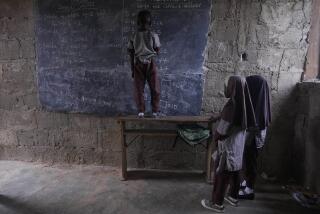Electricity Grows on Trees in Remote India Village
- Share via
KAMMEGUDA, India — Deep in the tropical forests of southern India, the Kolam people were untouched by telephones, cars or television. They went to bed at dusk because there was no electricity.
Their village is still far from a road or a power line. But, for the last year, dozens of 40-watt light bulbs have begun to glow in the mud-and-bamboo huts after the sun sets.
The villagers have found that electricity grows on trees -- specifically, the seeds of the Karanji trees in the nearby forest, which they’re turning into biodiesel fuel to power a generator.
Instead of going to sleep at sunset, children are busy practicing their alphabet in the community center each evening, writing their names on black slates and showing them to proud village elders, who never went to school.
“Our place has changed a lot,” said Kammeguda’s oldest man, Aathram Maru Patel, who does not recall his age and has never been away from the village.
The Kolams gather the seeds from the surrounding forest and take a few hours to extract the oil, using a mill powered by the generator that provides the electricity. There is substantially less pollution than from petroleum-based diesel, and no power bill.
“With lights, we can chase away snakes and animals that stray into our village in the night. We can catch the occasional thief also,” said Lakshmi Bai, chosen by her community to manage the tiny power station.
“Earlier, we used to put our children to sleep early, but now we make them study under the lights,” she said.
Udupi Shrinivasa, a gray-haired, bespectacled mechanical engineering professor at the Indian Institute of Science, walked into the village just over a year ago and brought light into the Kolams’ lives.
For years, he had been teaching the institute’s students about the mechanics of the diesel engine and the plan of its German inventor, Rudolph Diesel, for it to run on vegetable oils as a source of cheap energy.
Researchers around the world are working on replacing oil-based diesel with biodiesel fuels, which can be made from a variety of agricultural products, from animal fat to soybeans. Shrinivasa decided to apply that idea for the benefit of power-starved Indians.
“All we did was to take this rudimentary technology to people who had no means of getting all the energy they needed,” he said at his office in Bangalore, 560 miles south of this village in Andhra Pradesh state.
Until about 10 years ago, the Kolams hunted animals for food and lived in isolation. The state government then weaned the tribe away from hunting. Now, they keep poultry and cattle.
The electrical system has brought further change, and people from other villages in the forest are coming to see the lights of Kammeguda.
At sunset, the generator starts up and lights about 60 bulbs in 35 households, the 100-square-foot community center with bamboo walls and the village’s single lane.
As children study in the center, people sing community prayers and women paint their palms with decorative patterns of henna, a bright red herbal paste.
Women no longer have to walk several miles to fetch water. The generator runs a pump that draws underground water for storage in an overhead tank.
Next on the village’s wish list is a television set and a videocassette player.
Shrinivasa says the experiment in Kammeguda points to a possible solution of the power shortages that hinder economic expansion in India, home to 1 billion people. Biodiesel generators also could help cut India’s annual $18-billion bill for oil imports, he said.
Fifty-five percent of all rural households -- 77 million village homes -- do not have electricity. Even in the cities, only 87% of people have connections, and there are frequent power outages.
For cooking, lighting and heat, most villagers have to use firewood or kerosene, a dirty-burning fossil fuel whose sulfur and carbon monoxide can cause skin irritation and respiratory problems.
Kammeguda’s 120 inhabitants have put that behind them.
“Years ago, they lived primitive lives. We worked with them patiently to change many of their practices,” said Raj Prakash, an officer with the government’s tribal development agency, which began working with the Kolams a decade ago.
“They started wearing full clothes, putting their children in school, vaccinating them against diseases and cultivating crops. Now, electricity has made them ask for more.”
Working with Shrinivasa, the agency has helped the villagers grow Karanji trees and manage the project. Ten thousand trees planted by the Kolams last year will start yielding seeds soon.
The generator also is proving a boon for neighboring tribes, who are making seed oil and selling it to the Kolams.
Suryakala, 7, of Kammeguda, is happy she can devote more time to studying. She says her father has always told her that God provided in the jungle everything the villagers needed -- and now she has proof.
“God has given us light so that we can study,” she said.
More to Read
Sign up for Essential California
The most important California stories and recommendations in your inbox every morning.
You may occasionally receive promotional content from the Los Angeles Times.













